Aquatic Nuisance Species - Lakes Of Oklahoma
Aquatic Nuisance Species - Lakes Of Oklahoma
Aquatic Nuisance Species - Lakes Of Oklahoma
Create successful ePaper yourself
Turn your PDF publications into a flip-book with our unique Google optimized e-Paper software.
<strong>Lakes</strong> of <strong>Oklahoma</strong><br />
<strong>Aquatic</strong> <strong>Nuisance</strong> <strong>Species</strong><br />
Have you ever heard of<br />
Watermilfoil, Hydrilla, Didymo,<br />
Golden Algae, or Zebra Mussels<br />
These and many other flora and fauna<br />
that move in and change the ecosystem of our<br />
lakes have been dubbed by biologists as aquatic<br />
nuisance species or ANS. Most ANS are not<br />
indigenous to <strong>Oklahoma</strong>.<br />
Because they are aggressive reproducers with<br />
few, if any, local predators to keep them in<br />
check, ANS quickly get established, dominate,<br />
Prevention is the most effective tool.<br />
• Drain water from your boat, live wells, and bait containers<br />
before leaving the boat ramp.<br />
• Remove plants and mud from your boat and trailer.<br />
• Spray or rinse boats and equipment (or allow to dry for 5 days)<br />
before entering another lake or stream.<br />
• Never transfer plants or fish from one waterbody to another.<br />
• Don’t harvest bait from infested lakes.<br />
and change their environment. As ANS spread they often out-compete native species or devour food sources at<br />
such a rate that native species cannot survive. The new “monoculture” that results can drastically change<br />
the chemistry and the biological diversity of a waterbody.<br />
Once ANS get into a lake or stream, it may be impossible to remove them entirely. Furthermore, any<br />
attempt to completely eradicate or control ANS will likely result in harming native species as well.<br />
Zebra mussels, one of the most prominent ANS in our state, currently inhabit several stream systems in<br />
<strong>Oklahoma</strong>. This invader is continuing to spread with new infestations being found annually. These tiny mussels<br />
have the potential to reduce the productivity of infested systems and cause economic loss by clogging pipelines,<br />
locks and dams, marinas, and even outboard motors.<br />
Bighead carp have been found in the Neosho River, Red River, and Grand Lake. Although reproduction has<br />
not been verified in <strong>Oklahoma</strong>, this species has caused major economic and recreational losses in the upper<br />
Mississippi River system.<br />
The primary danger associated with<br />
aquatic nuisance species is the potential<br />
to disrupt the balance of our lakes.<br />
Golden Algae, which is responsible for fish kills that have<br />
completely decimated fisheries in several Texas reservoirs, appears<br />
to be migrating north. Golden Algae is attributed to a number of fish<br />
kills in both the Red River and Lake Texoma.<br />
Invasive plants often are moved from one system to another by boaters failing to remove plants, such as Eurasian<br />
watermilfoil and hydrilla, from trailers. Because combating ANS is so difficult, the best current strategy is to avoid<br />
further contamination by ANS altogether through public awareness and participation. It is crucial that <strong>Oklahoma</strong>’s<br />
boaters, fishermen, and other outdoor recreationalists understand the importance of cleaning boats, waders, or any<br />
water gear that may be contaminated with fragments or seeds.<br />
The Department of Wildlife Conservation has been assigned to lead the<br />
fight on this issue. You may learn more about these species from the<br />
ODWC website:<br />
www.wildlifedepartment.com/nuisancespecies.htm, or call 405.521.4623.<br />
The economic costs of aquatic nuisance<br />
species to the United States in 2000<br />
were estimated at $137 billion.<br />
10
<strong>Lakes</strong> of <strong>Oklahoma</strong><br />
Common <strong>Aquatic</strong> <strong>Nuisance</strong> <strong>Species</strong> in <strong>Oklahoma</strong><br />
ZEBRA MUSSELS: are small thumbnail sized mussels with striped<br />
patterning on their shells. The mussels attach to structures forming<br />
dense colonies reaching hundreds of thousands per square meter! A<br />
single female mussel can release up to one million eggs per season.<br />
Zebra mussels in large numbers reduce the availability of plankton<br />
and cause major economic loss clogging pipelines, locks, dams and<br />
boat motors. A general practice of washing your boat and equipment<br />
and allowing them to dry for several days is recommended.<br />
WHITE PERCH: as top competitors, they can quickly become the<br />
dominant species in freshwater lakes and are associated with declines<br />
in both walleye and white bass populations. White perch have been<br />
migrating throughout the Arkansas River Basin and are currently<br />
established in Kaw, Keystone, and Sooner <strong>Lakes</strong>.<br />
HYDRILLA: an aquatic plant rooted usually in the shallow portions<br />
of the lake, often becoming visible once it tops out above the water<br />
line. It has a long stem with whorled leaves. It can spread by seeds<br />
or simply small fragments that quickly take root. Hydrilla has been<br />
named the most damaging aquatic weed in the U.S. It has the ability to<br />
become densely established and outcompete native plant communities.<br />
Hydrilla is currently found in Arbuckle, Murray, and Sooner <strong>Lakes</strong>.<br />
EURASIAN WATERMILFOIL: a perennial evergreen that is<br />
distinguished from hydrilla by its flat leaves floating around a stem.<br />
A single fragment can become established in a lake bed and grow<br />
several inches per week. It will rapidly take over large areas of the<br />
lake’s littoral zone (shallow lake shoreline). This zone is where a<br />
diverse native plant community is essential to the health of a lake’s<br />
ecosystem.<br />
DIDYMO: commonly called “rock snot”, is an invasive algae that attaches to<br />
rocks and plants in streams and rivers. It can completely smother gravel<br />
and rocks, reducing the available spawning and feeding habitat for fish<br />
and other organisms. Over time, it can form mats so dense that they<br />
are no longer fishable. Didymo is currently established in the Lower<br />
Mountain Fork River. After visiting this river be sure to wash your<br />
waders with a 2% bleach solution or dishwashing detergent.<br />
BIGHEAD CARP: first documented in Grand and Hudson lakes almost 15<br />
years ago. They have been recently sighted in the Kiamichi River below<br />
Hugo Reservoir, making their presence likely in the Red River. Native to Asia,<br />
these fish deplete zooplankton populations, leading to reductions in native<br />
fish populations, impacting both commercial and recreational fishing.<br />
GOLDEN ALGAE: a tiny yellow-green single-celled organism that releases<br />
toxins to gill-breathing organisms (such as fish and mussels) as it rapidly<br />
reproduces into blooms. It has reportedly killed 7.6 million fish in Texas<br />
lakes and rivers since 1985. It has been documented to be working its<br />
populations into southern <strong>Oklahoma</strong>. It currently prefers the more saline<br />
waters found near the Red River basin at this time.<br />
11





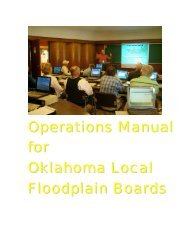
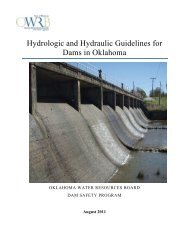
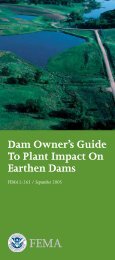

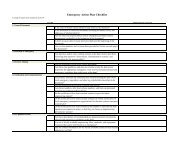
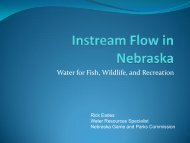




![A Commodity & a Resource [pdf] - Water Resources Board - State of ...](https://img.yumpu.com/42536671/1/190x143/a-commodity-a-resource-pdf-water-resources-board-state-of-.jpg?quality=85)

